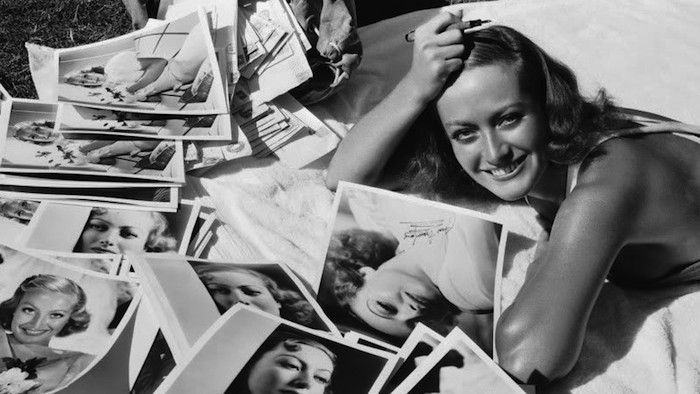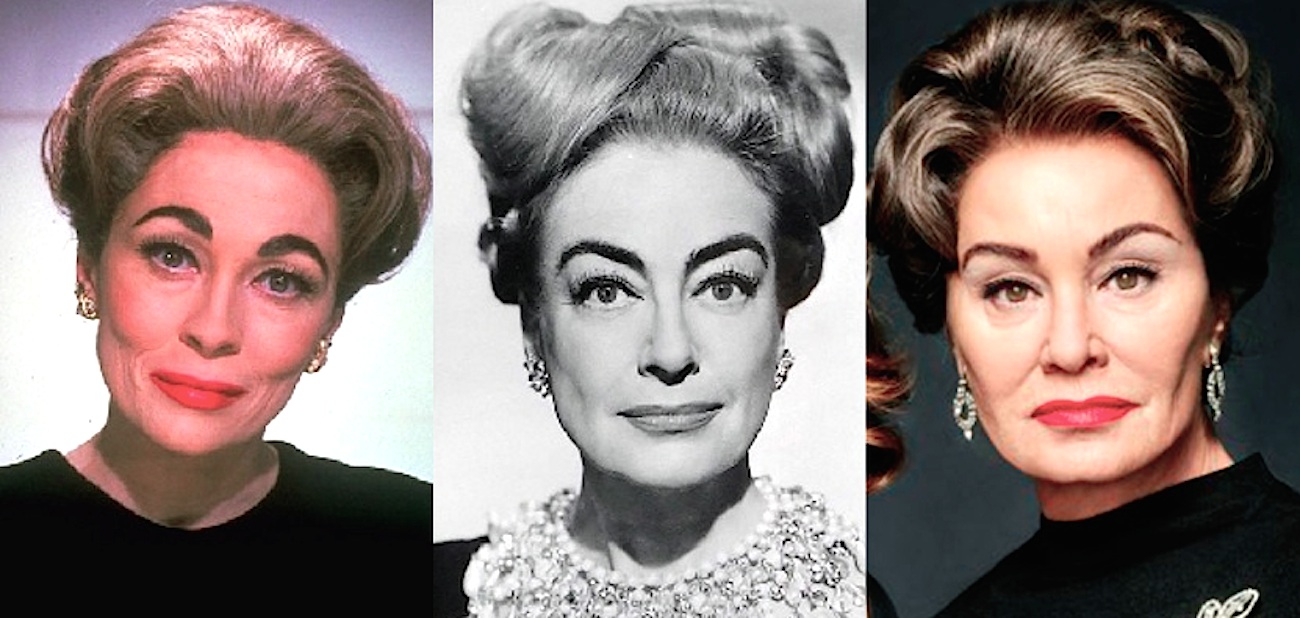On this day in 1904, Lucille Fay LeSueur (later known as Joan Crawford) was born in San Antonio, Texas. Some sources list the year of her birth as 1904, 1905, or even 1908, but a quick search of the San Antonio census records reveals the truth. By any measure, Crawford was one of the greats in the history of Hollywood.
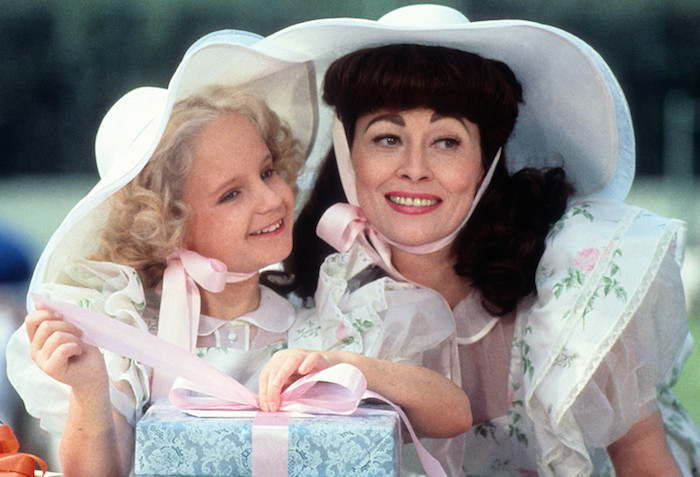
I recently watched the 1981 film Mommie Dearest for the first time in decades. While Faye Dunaway’s depiction of Crawford over the course of almost 40 years is dead on, it sometimes seems as if she’s using Carol Burnett’s parodies of Joan Crawford as her source material rather than the actress herself. The way Dunaway transforms herself through makeup, hair, costumes and her exquisite acting chops is one degree short of channeling, but her performance is so over-the-top that you have to wonder what the filmmakers were going for. What could have been a truly incisive look at the stresses and psychological issues of a well known figure is instead an exercise in High Camp even though I don’t think that was anyone’s intention at the time, least of all Faye Dunaway’s (who refuses to discuss this film today). I’m not sure director Frank Perry was the right man for the job, and yet he did direct two films that I thought were outstanding depictions of mental disorders: David and Lisa in 1962 and the classic Diary of a Mad Housewife in 1970.
I have long wished for a new look at Joan Crawford on the screen, one that would treat her life and issues more seriously, not as a big punchline. But I never dreamed it would actually happen — I was sure that Faye Dunaway’s larger-than-life depiction was the last time we’d ever see a talented actress donning Crawford’s red lipstick and shoulder pads. I was wrong!
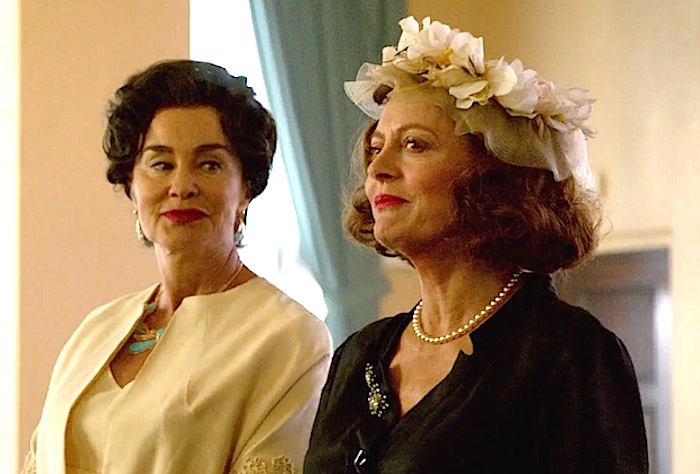
Ryan Murphy’s eight-part series Feud, currently running on FX, details the production of the 1962 Robert Aldrich film, What Ever Happened to Baby Jane? Though we’ve only seen half of the episodes, I have to say that I am deeply moved by the performances of Jessica Lange as Joan Crawford and Susan Sarandon as Bette Davis.
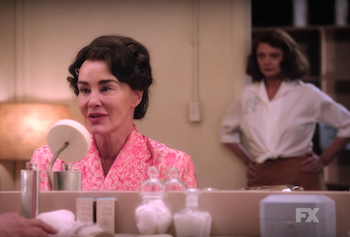 Not everyone in my circle of classic movie-loving friends agrees, but I find Lange and Sarandon’s depictions highly skilled and nuanced. Yes, What Ever Happened to Baby Jane? has itself become a camp classic on par with Mommie Dearest, and this series focuses on the bitter rivalry between the two stars as they grappled with the agonies of being middle-aged in Hollywood (Davis was 54 and Crawford 58 during the making of that film, not old by today’s standards but in Hollywood they were considered ancient relics), but Feud also looks beyond the Hedda Hopper-ish “dirt” to the living and breathing women behind the icons, with all their wisdom, experience, insecurities, and vulnerabilities on full display. I think Sarandon and Lange, themselves 70 and 67, are remarkable in the roles.
Not everyone in my circle of classic movie-loving friends agrees, but I find Lange and Sarandon’s depictions highly skilled and nuanced. Yes, What Ever Happened to Baby Jane? has itself become a camp classic on par with Mommie Dearest, and this series focuses on the bitter rivalry between the two stars as they grappled with the agonies of being middle-aged in Hollywood (Davis was 54 and Crawford 58 during the making of that film, not old by today’s standards but in Hollywood they were considered ancient relics), but Feud also looks beyond the Hedda Hopper-ish “dirt” to the living and breathing women behind the icons, with all their wisdom, experience, insecurities, and vulnerabilities on full display. I think Sarandon and Lange, themselves 70 and 67, are remarkable in the roles.
Feud also looks at aspects of the questionable parenting of both women, but presents it in a much more compassionate way despite many cringe-producing moments. Davis’s daughter, B.D. Hyman, who would eventually write her own tell-all about her mother, actually had a small role in What Ever Happened to Baby Jane? although it was clear from the start that she did not inherit her mother’s acting ability. Played by the talented Kiernan Shipka (Sally Draper from Mad Men), we see Davis and B.D. struggling through difficult moments in their relationship as mother and daughter as well as fellow actors. In 1962, Crawford’s two older children were out of the picture but we see Crawford interacting with her teenaged twin daughters who would later refute the charges leveled by their older sister.
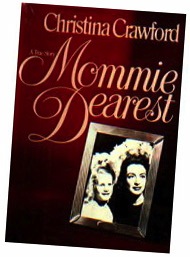 When Christina Crawford’s tell-all book came out a year after her mother’s 1977 death, Old Hollywood divided into two camps: those who thought the book represented the slanderous ravings of a spoiled brat bent on revenge for being written out of her mother’s will; and those who said they had witnessed Crawford’s unstable behavior with her children and were convinced that the book’s shocking claims were true. At the top of the list of Joan’s defenders was her old friend Myrna Loy who had known Crawford since she first arrived in Hollywood in the 1920s and had appeared with daughter Christina in a stage production of Barefoot in the Park. Loy disliked Christina and said that she had behaved horribly during the run of their play. She said that while she never saw Joan hit her daughter, if anyone needed a good slap it was Christina. Yikes.
When Christina Crawford’s tell-all book came out a year after her mother’s 1977 death, Old Hollywood divided into two camps: those who thought the book represented the slanderous ravings of a spoiled brat bent on revenge for being written out of her mother’s will; and those who said they had witnessed Crawford’s unstable behavior with her children and were convinced that the book’s shocking claims were true. At the top of the list of Joan’s defenders was her old friend Myrna Loy who had known Crawford since she first arrived in Hollywood in the 1920s and had appeared with daughter Christina in a stage production of Barefoot in the Park. Loy disliked Christina and said that she had behaved horribly during the run of their play. She said that while she never saw Joan hit her daughter, if anyone needed a good slap it was Christina. Yikes.
Helen Hayes, however, another great actress whom Joan had befriended in the 1930s, did not exactly elect Joan Mother of the Year in her autobiography:
Joan was not quite rational in her raising of children. You might say she was strict or stern. But cruel is probably the right word.
When my young son Jim came to stay with me, we would go out to lunch with Joan and her son Christopher. Joan would snap, “Christopher!” whenever he tried to speak. He would bow his little head, completely cowed, and then he’d say, “Mommie dearest, may I speak?” Joan’s children had to say [that] before she allowed them to utter another word. It would have been futile for me or anyone else to protest. Joan would only get angry and probably vent her rage on the kids.
I have read that people who are abused as children often become abusive parents. Maybe it was Joan’s tough childhood that made her exert her power like that over her own children. But understanding the reason did not make their suffering any easier to watch.
 Pretty damning stuff, and yet were many who claimed that Christina Crawford exaggerated some of the childhood episodes for dramatic purposes. I admit that certain scenes from the film that so appalled me when I first saw it in the 1980s don’t seem that bad today. At Christmas time and on birthdays, Joan’s fans would send Christina mountains of presents. Crawford would let her keep one or two and have her give the rest to needy children. This is presented in the film as monstrous abuse but I have to say that it seems pretty reasonable to me today. Still, it’s clear that there were times when Crawford’s highly disciplined and controlling nature devolved into episodes of severe mental and physical abuse. The last thing I would ever do is accuse Christina Crawford of lying about her own childhood. I would think that the only thing worse than experiencing such abuse is telling people about it and not being believed. Only she knows what happened between her and her mother and it certainly seems like Joan had plenty of issues that made her a challenge to live with. On the other hand, I wish the makers of Mommie Dearest had avoided the temptation to create completely fictional scenes of terror like the one in which Joan almost kills Christina in front of a magazine reporter.
Pretty damning stuff, and yet were many who claimed that Christina Crawford exaggerated some of the childhood episodes for dramatic purposes. I admit that certain scenes from the film that so appalled me when I first saw it in the 1980s don’t seem that bad today. At Christmas time and on birthdays, Joan’s fans would send Christina mountains of presents. Crawford would let her keep one or two and have her give the rest to needy children. This is presented in the film as monstrous abuse but I have to say that it seems pretty reasonable to me today. Still, it’s clear that there were times when Crawford’s highly disciplined and controlling nature devolved into episodes of severe mental and physical abuse. The last thing I would ever do is accuse Christina Crawford of lying about her own childhood. I would think that the only thing worse than experiencing such abuse is telling people about it and not being believed. Only she knows what happened between her and her mother and it certainly seems like Joan had plenty of issues that made her a challenge to live with. On the other hand, I wish the makers of Mommie Dearest had avoided the temptation to create completely fictional scenes of terror like the one in which Joan almost kills Christina in front of a magazine reporter.
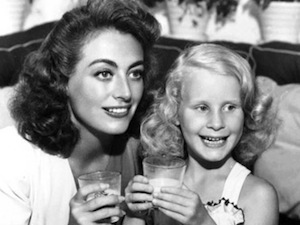 As far as Joan’s friends defending her, it’s true that you never really know what goes on behind other people’s closed doors. Still, Christina Crawford hasn’t helped her “case,” in my opinion, by encouraging the camp-fest that has developed around the book and movie of Mommie Dearest. She has appeared at screenings with drag queens playing her mother and at which the crowd interacts with the film à la Rocky Horror using props. The last time I saw the film in a theater, an AFI-sponsored screening for its 25th anniversary in 2006, I was uncomfortable at the uproarious laughter that greeted so many scenes. If the story is true, we are laughing at horrific child abuse. If it is an exaggerated tale of a troubled childhood, we are participating in a major defamation of character of a woman who is not here to defend herself and whose public image (the one thing everyone who knew Joan Crawford said she cared about more than anything) has been utterly trashed.
As far as Joan’s friends defending her, it’s true that you never really know what goes on behind other people’s closed doors. Still, Christina Crawford hasn’t helped her “case,” in my opinion, by encouraging the camp-fest that has developed around the book and movie of Mommie Dearest. She has appeared at screenings with drag queens playing her mother and at which the crowd interacts with the film à la Rocky Horror using props. The last time I saw the film in a theater, an AFI-sponsored screening for its 25th anniversary in 2006, I was uncomfortable at the uproarious laughter that greeted so many scenes. If the story is true, we are laughing at horrific child abuse. If it is an exaggerated tale of a troubled childhood, we are participating in a major defamation of character of a woman who is not here to defend herself and whose public image (the one thing everyone who knew Joan Crawford said she cared about more than anything) has been utterly trashed.
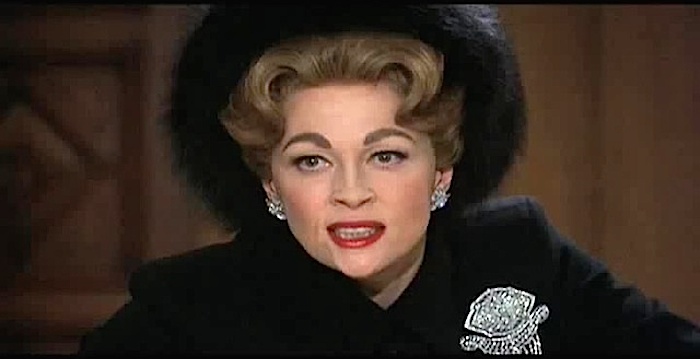
Not that I can truly blame the audience for laughing or claim that I took the high road and didn’t join in from time to time. How can you not laugh at lines that are so out there they have become indelible parts of our pop culture such as “Christina, bring me the ax!” or the iconic “NO WIRE HANGERS…EVER!!” My personal favorite is a scene that I think shows Joan in a positive light even though she’s clearly being a Class A bitch. After her fourth husband, Pepsi-Cola honcho Al Steele dies, the top brass at Pepsi try to kiss her off. Never one to meekly slither away, Joan Crawford lays into the Board and threatens to use her fame to turn her fans against Pepsi if they continue their campaign to get rid of her. After years of dealing with the sleazeballs of Hollywood, Joan was not about to let this group give her the heave-ho. “Don’t fuck with me, fellas!” she spews with an evil smile on her face. “This ain’t my first time at the rodeo.” I hope she really said that, it’s such a great line.
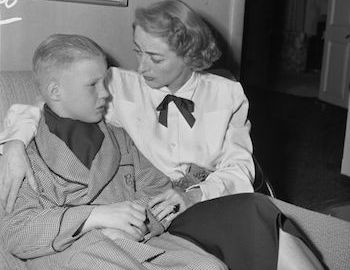 While the Crawford twins, Cathy and Cynthia, that we see in Feud always defended their mother against their sister’s charges, Joan’s adopted son, Christopher, definitely did not. Though he was never as interested in sharing his story with the world as Christina had done, his own childhood was every bit as troubled. As a young boy, Christopher ran away from home several times. At 12, Joan placed him is a residential military academy but it didn’t curtail the trouble the boy constantly got into. Following Crawford’s death and the release of his sister’s book, he finally agreed to talk to a newspaper reporter in 1978 about his unhappy childhood.
While the Crawford twins, Cathy and Cynthia, that we see in Feud always defended their mother against their sister’s charges, Joan’s adopted son, Christopher, definitely did not. Though he was never as interested in sharing his story with the world as Christina had done, his own childhood was every bit as troubled. As a young boy, Christopher ran away from home several times. At 12, Joan placed him is a residential military academy but it didn’t curtail the trouble the boy constantly got into. Following Crawford’s death and the release of his sister’s book, he finally agreed to talk to a newspaper reporter in 1978 about his unhappy childhood.
“I want to tell this once, so people will get off my back and leave my family alone,” says the 6-foot-4 man whose hard life shows in his face. He needs dental work. There are small scars on his face and larger ones on his back from a mortar explosion in Vietnam.
Crawford recalled his mother’s “sleep safe,” the harnesslike device used to keep infants securely in their beds. Chris was strapped into bed until the age of 12. Once caught playing with matches, his mother made him hold his hand in the fireplace. “I had blisters all over my hand. That day I ran away for the first time. I was 7.”
Though Chris attended his mother’s funeral, his last encounter with J.C. was five years ago. His youngest child was born in Brooklyn, on welfare. “When Bonnie was born, she had a lot of trouble. She was just a tiny little mass of bones with some skin stretched over them. So I called J.C. and said, ‘I need your help. Your granddaughter needs blood and she needs it now. She might die.’ J.C. said, ‘She’s not my granddaughter. You were adopted.’ I lost my temper and slammed down the phone so hard I broke the receiver. That was it between J.C. and me.”
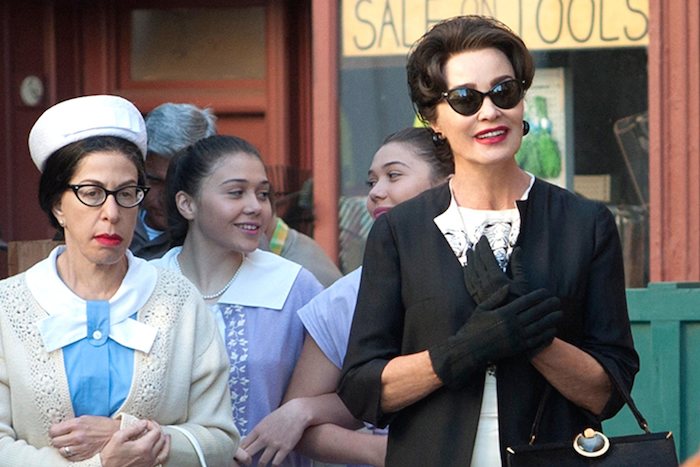
FEUD: Bette and Joan — “Mommie Dearest” — Installment 1, Episode 3 (Airs Sunday, March 19, 10:00 p.m. e/p) –Pictured: (l-r) Jackie Hoffman as Mamacita, Jessica Lange as Joan Crawford. CR: Suzanne Tenner/FX
That’s as bad as anything in Mommie Dearest. Christopher Crawford died of cancer on September 22, 2006. Cynthia Crawford died the following year. It’s quite possible that Christina and Christopher’s perspectives about their mother were as true and valid as their younger sisters’ claims of a strict but very loving mother. In any event, I’m grateful to Ryan Murphy and Jessica Lange for allowing the world to see a more multifaceted and complex version of Joan Crawford, albeit another fictionalized take that is open to different interpretations. Few people cared more about their career or their public image than Joan Crawford and I’m happy that this poignant examination of the screen legend doesn’t treat her incredible and often tragic life as one big joke. Happy Birthday, Joan!
